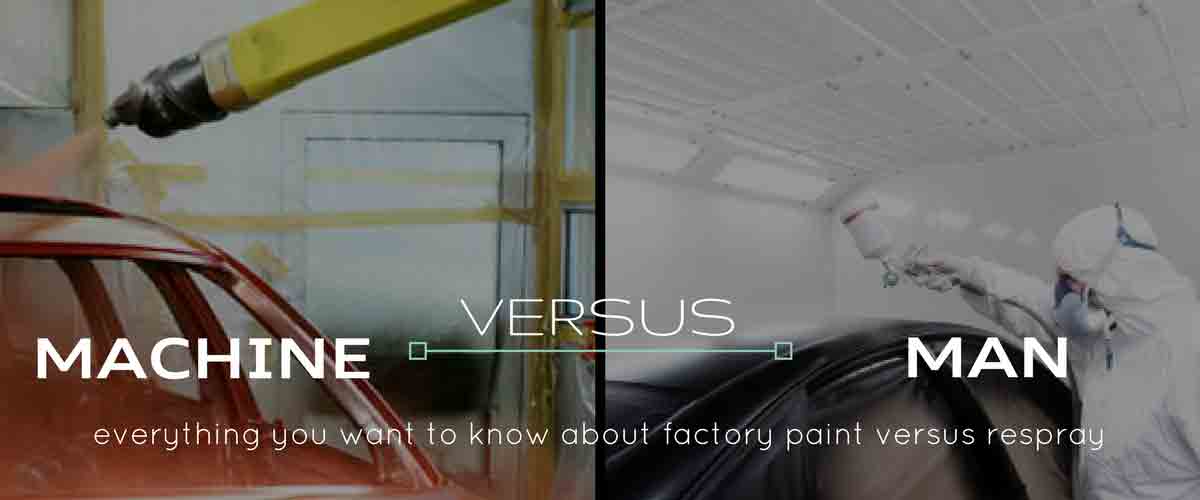Original Factory Paint versus Repaint – What should your Car Polisher know?

Have you ever noticed that in many cases the color of a vehicle’s bumpers doesn’t exactly match the colour of the vehicle body? You might have noticed this recently on your own cars after the bumper was painted by a spray paint bodyworks shop as a result of a minor parking lot fender bender. The repainted rear bumper was, clearly a different colour than the rest of the body.
If this colour disparity heightened your awareness of the issue; let us try to find out what causes it and, more importantly, how we can limit the issue all together here at EA Detailer.
If your initial thought was that the body shop performing the repairs on the car either didn’t mix the paint correctly, or chose the wrong color variant. Every vehicle color has a particular code designation. For example, the paint code on this car is NH701M (found on a sticker inside the driver’s side door jamb). An auto body shop would type this code into a computer software and would receive a list of tints and dyes to mix together to re-create the original factory colour. Seems easy enough, right? Well, not always.
Vehicle manufacturers mix large volumes of paint for spraying vehicles on a particular assembly line. Yet what happens if the manufacturer has multiple assembly lines, or if they have to mix a new batch of paint? Variance. That is, even vehicles painted by the factory with the same paint code can have slightly different colours.
Manufacturers periodically publish the formulas for mixing variants using somewhat cryptic descriptors such as, “darker”, “lighter”, “yellower”, “dirtier”, etc. So it is then up to the body shop to determine which colour variant is closest to the original factory colour of the vehicle. But what about an older vehicle on which the original factory paint is slightly faded? Painting the repair area with the original factory colour clearly won’t match the existing paint in this case. So, in the case of variants, or aged paint, it is up to the body shop to determine the best colour to spray. This is done by mixing a batch of paint and spraying a small test card. Once the paint dries on the test card, it is held up next to the vehicle to see if the colour matches. The painter determines if a new variant should be mixed, or if adding different tints will match the existing paint.
So, now let’s say that the body shop has determined the best colour match and they spray the new or repaired bumper cover on my car – but the colour still doesn’t match! Well, then we need to look at the substrate (the surface that we are painting). Most of the vehicle surface is metal whereas the bumper covers, mirror covers, mud guards, etc., are all plastic.
Applying the same paint on plastic and metal can often result in a slightly different colour appearance. This can be due to several factors. First, the plastic dissipates heat more slowly than metal (the paint dries slower), and drying time can be a key factor in paint appearance. As paint dries more slowly, metal flakes in the paint have more time to settle at different angles, and volatile chemicals have more time to evaporate – causing slight variance in the paint colour. Another factor is that plastic can hold more static electricity charge than metal and, if not properly discharged before spraying, can cause metal flakes to align differently than on a metal surface. Substrate differences require different spraying techniques to minimise paint colour variations.
Well, now we have the colour matched and we’ll use different spraying techniques to minimise the difference between the factory paint and the newly sprayed paint – the colour must surely match now! Not necessarily. Most modern factories use electrostatic spray equipment to paint the metal surfaces of an automobile. While they use conventional spray equipment to paint the plastic surfaces. So, even vehicles coming off of the factory line can have slight variations in colour due to the differences in spray equipment.
And even accounting for all of these differences, colours can still seem slightly different simply due to the way light reflects and refracts off of curved surfaces (like a bumper) versus the relatively flat surfaces of the doors and hood.At EA Detailer we’ve learned to take all of these factors into account when polishing a repaired surface.
First, we take the time to properly access the repaired surface which is repainted. Next, we research, formulate, and customised the best car polish system to apply. We then do a test polish to find the best results.
Finally, we alter our techniques to account for environmental conditions (such as humidity and air temperature), All of this to ensure that the final glow is being accentuated and brought to life.
We believe that if we take a few extra minutes to properly access and prepare a surface, and take the time to really find the exact polishing technique, we save your time and money in the long run by not having to preserving the repainted surface.
Reach out to us now for further assistance if you wish to find out more about the paintwork condition of your Own Car!
– Whatsapp us at https://www.eadetailer.com/speak2us/
– Call in at 6917 8396
